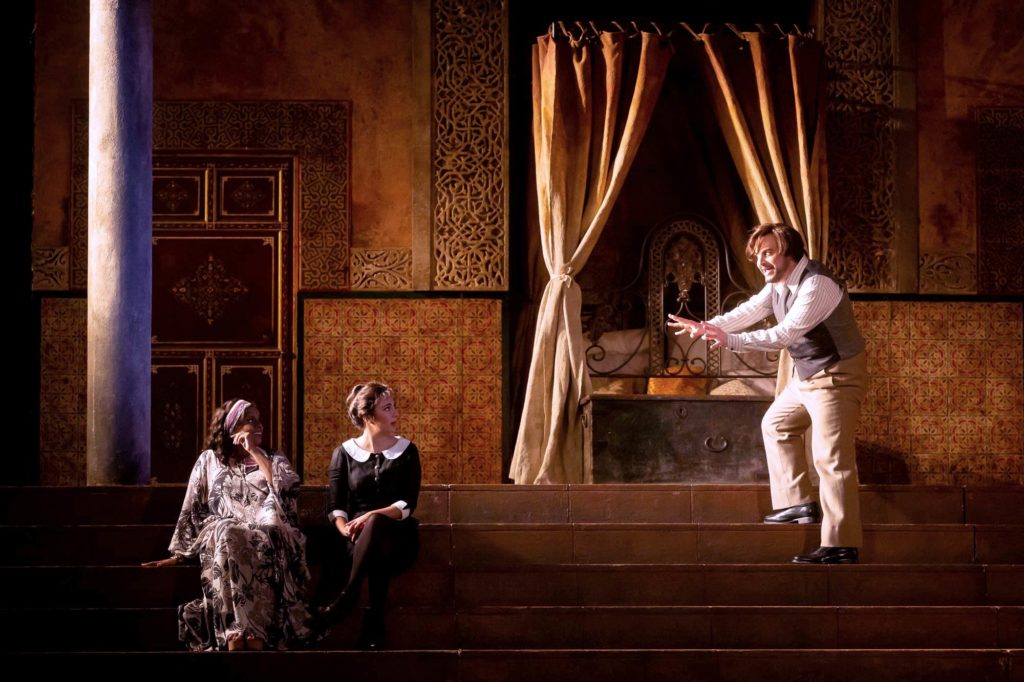Houston Grand Opera’s “Figaro” is a nimble and heartfelt delight

Houston Grand Opera obviously knows that it has a lengthy work on its hands: It’s raising the curtain on evening performances of The Marriage of Figaro at 7 p.m., 30 minutes earlier than usual. More importantly, HGO is treating Mozart’s comedy to a production that moves as quickly as the resourceful Figaro’s mind. The intrigues and hijinks that nearly derail the barber-turned-valet’s wedding almost never let up.
In the opening performance Friday at Wortham Theater Center, conductor Patrick Summers and the HGO Orchestra kept the music’s fleetness and sparkle in the forefront. Summers even boosted the narrative momentum, adding tempo to scenes that sometimes flag under other conductors. A perfect example is when the Count and Countess Almaviva open a closet and discover, to their amazement, that the Countess’s chambermaid Susanna — Figaro’s fiancée — is hiding there instead of the page boy Cherubino, whom the Countess had seen lock himself inside.
Summers did relax the pace on occasion — for instance, to bring out the soulfulness of the Countess’s arias as she looks back to happier times when her husband wasn’t a skirt-chaser. But those flights of lyricism only heightened the effect of the prevailing excitement.
Sitting down to the fortepiano to accompany the sung-dialogue recitatives, Summers threw in keyboard flourishes that accented the musical and theatrical bustle. HGO’s cast picked up on the energy. Bass Nahuel Di Pierro’s Figaro was lusty-voiced and — literally and figuratively — light on his feet. After Susanna tells her betrothed that the Count is trying to seduce her, Di Pierro let the anger bubble up in his singing, first in the recitative and straight on into Figaro’s first aria, “Se vuol ballare.”
He put a more jovial vigor into “Non piu andrai,” as Figaro dispatches Cherubino to begin his life in the army. In the last act, when Figaro mistakenly thinks Susanna intends to let the Count have his way, Di Pierro put more snarl into Figaro’s tirade about women, “Aprite un’ po.” But whenever the mood was cheerier, especially in scenes with Susanna, Di Pierro filled the music the music deftness and pizazz.
As Susanna, soprano Elena Villalón complemented Di Pierro’s red-bloodedness with her bright, airy singing. In the comic numbers, Villalón radiated Susanna’s impish glee. But when Susanna thinks Figaro is dropping her to marry the conniving courtier Marcellina, Villalón’s voice took on an edge that delivered the message as surely as the slap of her hand across Figaro’s face.
Villalón revealed another side to both her character and her voice in the last act, imbuing “Deh vieni, non tardar” — another of the opera’s few stretches of lyrical repose — with a romantic lilt and glow.
Bass-baritone Adam Plachetka, who played Figaro when HGO introduced director Michael Grandage’s production in 2016, switched to the Count this time. The move suited him: Burly and about a head taller than most of the other principals, Plachetka was built to portray a guy who’s accustomed to throwing his weight around.
His voice — big, dark and deep — captured the persona, too. Whenever the Count is agitated by events that thwart his desires, the sheer heft of Plachetka’s singing showed it — and balanced it with half-shades that captured the Count’s occasional bewilderment. When frustration finally boils over in the Count’s Act 3 aria, Plachetka pulled out all the stops, letting loose in the aria’s climax with flareups of sheer rage.
Soprano Nicole Heaston brought the opposite flavor to the long-suffering but ever-hopeful and ultimately forgiving Countess. Heaston harkened back to the warmth and poise of her Mimi in HGO’s 2018 staging of Puccini’s La Boheme.
Rather than let stereotypes about Mozartean refinement hem her in, she spun out the Countess’ two arias in glowing, generous phrases. But she never took that so far as to make Mozart sound syrupy.
Like all the principals, Heaston occasionally embellished Mozart’s vocal lines — in her case playing up the music’s euphony and grace. Plachetka, on the other hand, tailored the Count’s aria with high notes that helped ratchet up its ferocity.
Soprano Lauren Snouffer was the other carryover from HGO’s 2016 cast, again playing the page boy Cherubino — an adolescent portrayed by a woman. Snouffer made the girl-crazy youth a bundle of energy through her demeanor and singing alike. In the breathless “Non so piu,” she capped off her vault through the aria with an energetic cadenza. Even in the more lyrical “Voi che sapete,” Snouffer’s vibrant singing captured the undercurrent of adolescent excitement.
The conniving courtiers who try to disrupt the wedding all cut lively figures.
Bass Patrick Carfizzi’s Bartolo let fly with booming tones as he dreamed of revenge against Figaro. Mezzo-soprano Marie Lenormand made Marcellina, who at first hopes to marry Figaro, a stern woman who eventually softens.
Tenor Steven Cole captured Basilio’s conspiratorial glee through his lithe voice and gleaming eyes. And soprano Erin Wagner brought the role of Barbarina, a girl drawn into the edges of the scheming, a warmer voice than the soubrettes often cast in the part.
Grandage’s production, staged this time by revival director Ian Rutherford, updates the story to Franco-era Spain. American opera audiences of today may not connect much with that. But to judge by Friday’s crowd, they do relate to the visual reminiscences of the 1960s — especially when the wedding-party revelers throw themselves into the twist and other hip-swinging dances.
Christopher Oram’s set, meanwhile, evokes a filigreed, Moorish-style villa that could serve just as well for a production set in the opera’s original period. Maybe that should remind us that Figaro is, after all, timeless.
The Marriage of Figaro runs through Jan. 28. houstongrandopera.org


